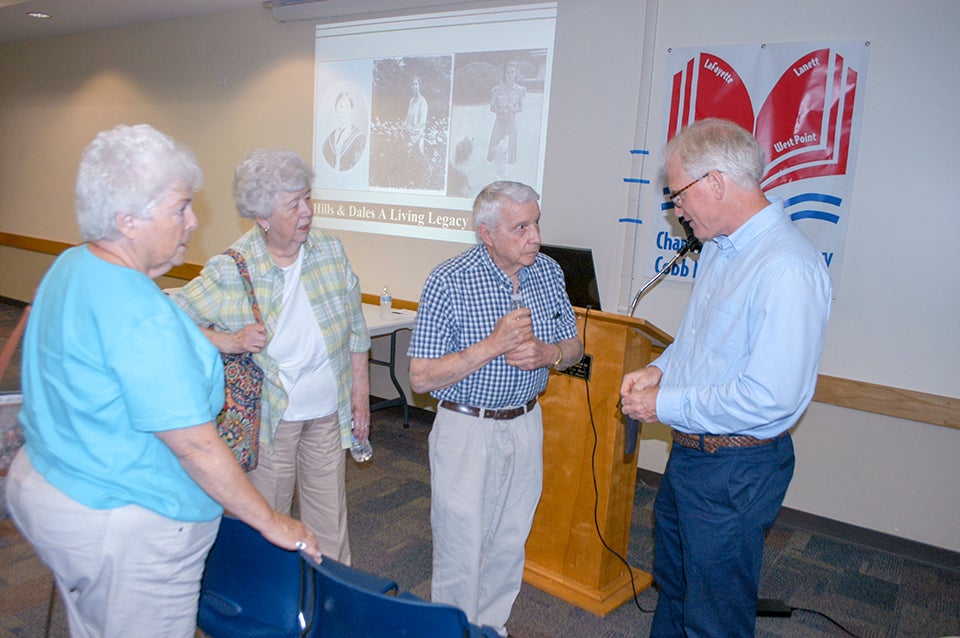Library planning trip to Hills and Dales estate
Published 7:17 pm Thursday, May 16, 2019

- Hills & Dales Executive Director Carleton Wood (at right) answers a question posed by Richard Perryman at the Friday, May 10 Lunch N Learn program at Bradshaw-Chambers County Library. — Wayne Clark
VALLEY — Registration is under way for a day trip to Hills & Dales Estate in LaGrange. A carpool will be leaving the parking lot outside Bradshaw-Chambers County Library at 9 a.m. EDT on Thursday, May 23. The cost for the trip is $18.
Completed in 1916, the 13,000-square-foot Fuller E. Callaway home was designed to flow gracefully into an existing boxwood garden that’s now more than 175 years old and is widely considered one of the best preserved 19th century gardens in the U.S.
To preview the upcoming trip, the library hosted a Lunch N Learn program during the noon hour on Friday, May 10. Hills & Dales Executive Director Carleton Wood was there to discuss the Callaway home and the nearby garden, which was maintained by three extraordinary women: Sarah Coleman Ferrell, Ida Cason Callaway and Alice Hand Callaway.
The gardens date to Troup County’s earliest days. Ferrell Gardens began in 1832 on land that had been cleared to grow cotton. Nancy Ferrell started them, and the gardens were expanded by son and daughter-in-law Blount and Sarah Ferrell in the 1840s and into the 20th century.
“Most of the time a house is built first and gardens are added around it,” Wood said. “The Ferrells and the Callaways did it backwards. The gardens came first.”
A woman of deep religious faith, Sarah Ferrell incorporated various religious symbols and motifs into the design of her gardens. She grew a wide variety of plants and made use of locally quarried stone to create walls, steps and terraces.
Also called “The Terraces,” the Ferrell Gardens became nationally known and were open to the public. Sarah Ferrell became widely admired for her skill in creating beautiful gardens. She also had a hand in the colorful show golf fans see every year in The Masters at Augusta National. Wood said that she had rows of plants growing there as early as the 1840s.
Ferrell Gardens in LaGrange was her masterpiece. In the 1870s a travel guide writer said the Ferrell Gardens was the finest place he’d visited in 30 states and compared it favorably to the famed Missouri Botanical Gardens. Sarah began a daily habit that would later be carried on by the Callaway women — she kept daily notes of what she had done in the garden, what she had planted, what she’d pruned and what she’d liked to do in the next growing season.
Sarah died in 1903, and her husband passed away five years later. They were survived by one son, Clarence, who did not want to maintain the family home and its garden. In 1912, he sold the family estate to Fuller E. Callaway.
Callaway (1870-1928) was a well-to-do textile mill owner at the time and had been a natural entrepreneur from an early age. At 18, he’d opened a five-and-dime store in downtown LaGrange and later owned several other profitable businesses. Before the turn of the century, he had invested in the textile business and was employing thousands of people. He married Ida Jane Cason (1872-1936) of Jewell, Georgia. in 1891, and they had two sons, Cason Jewell Callaway (1894-1961) and Fuller Jr. (1907-1992). Both sons grew up working in and managing their father’s mills, which were sold to Deering-Milliken in 1968.
Cason married Virginia Hollis Hand (1900-1995) of Pelham, Georgia and Fuller Jr. married her younger sister, Alice Hinman Hand (1912-1998) some 10 years later. Following their mother’s death in 1936, her two sons submitted sealed bids for Hills & Dales to see who would get the family home.
“Fuller Jr. worried half the night that he wouldn’t get the place and half the night he would,” Wood said. “The bids were close, but in the end Fuller Jr. and Alice moved into the family home.”
Following Alice’s death in 1998, the estate was bequeathed to the Fuller E. Callaway Foundation.
Though losing out on the sealed bid, Cason didn’t do too badly. After retiring from the mills at an early age, Cason worked on developing better farming practices at his Blue Springs Farm near Hamilton, Georgia. He and Virginia opened Ida Cason Callaway Gardens in 1952. At one time, Cason Callaway owned an estimated 60,000 acres of land in Harris County.
Wood said that Fuller Callaway Sr. had first seen the Ferrell Gardens when he was a boy making deliveries for Bradfield’s in downtown LaGrange.
“He made lots of deliveries to Sarah and her husband,” he said. “He’d also known them from church.”
By the time the Ferrell Gardens went up for sale in 1911, Callaway had made a fortune in the textile industry.
He made the highest offer for the land and purchased it from Clarence Ferrell for $8,000, which was a fair market price at the time.
Five years later, in 1916, Callaway wanted to do something special for his 25th wedding anniversary – to give wife Ida a house that cost $125,000, an astronomical figure for that day.
Acclaimed architect Neel Reid was hired to design it. Reid sought to do it in a way to complement the Italian-style boxwood gardens that had been created by the Ferrells.
The design is said to have been inspired by one of Reid’s favorite architects, Charles Adams Platt, who was noted for his adaptations of Italian villas set in formal landscape gardens.
The home’s Italian style is evident in its white stucco exterior and red tile roof. The east side of the home presents a grand two-story semi-circular portico with Ionic columns. Reid’s classic style is seen in the interior of the home with its double staircase, stone fireplaces and the long, narrow palm roof with marble ceiling and low marble wainscot.
The beautiful home is the centerpiece of the 35-acre Hills & Dales Estate. The 31-room home is surrounded by the spectacular boxwood garden planted in the mid-19th century by Sarah Ferrell.
The property has been carefully preserved by two generations of the Callaway family and is now open to the enjoyment of the visiting public.
The home has its curious features.
“There are 85 keys to the house,” Wood said. “There’s a different key for every door.”
Fuller Callaway Sr. lived there from 1916 until his death in 1928. Fuller Jr.’s wife, Alice, had the longest tenure in taking care of the gardens.
“She cared for them for 62 years,” Wood said. “She grew hundreds of rare and unusual plants while keeping Sarah’s basic design.”
Wood said that some visitors to Hills & Dales Estate have commented that “everything’s not in bloom.”
“Mrs. Callaway wanted it that way,” he said. “Everything’s not supposed to be in bloom at the same time. She wanted something blooming throughout the year. She loved day lilies, conifers and mimosas.”
Wood said what’s remarkable about the Ferrell Garden is that it bears the signature work of three different women, all of whom dearly loved the place.
“There are things in the garden that Sarah did, things Ida did and things Alice did,” Wood said.
Wood added that people are always asking why is the estate called Hills & Dales.
“Why not the Callaway Estate?” they ask.
“Fuller Sr. and Ida called it that,” he said. “They called it Hills & Dales because they added land to it.”
Hills & Dales Estate opened in 2004. There’s a new visitor center where people see video presentations about the Estate and its history.
There are also artifacts that date to the Ferrell Garden and to the Callaway years.
“Our Foundation is overseen by five Callaway grandchildren,” Wood said. “They are all in their 50s and 60s now.”




